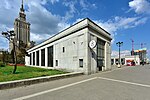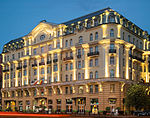St. Barbara's Church, Warsaw
19th-century Roman Catholic church buildings in PolandCommons category link is locally definedEurope Roman Catholic church stubsPolish church stubsRoman Catholic churches in Warsaw

St. Barbara Church (Polish: Kościół Świętej Barbary) is a Roman Catholic church in the Śródmieście district of Warsaw, Poland.
Excerpt from the Wikipedia article St. Barbara's Church, Warsaw (License: CC BY-SA 3.0, Authors, Images).St. Barbara's Church, Warsaw
Nowogrodzka, Warsaw Śródmieście (Warsaw)
Geographical coordinates (GPS) Address Phone number Website Nearby Places Show on map
Geographical coordinates (GPS)
| Latitude | Longitude |
|---|---|
| N 52.226513 ° | E 21.00717 ° |
Address
Kościół pw. Świętych Apostołów Piotra i Pawła
Nowogrodzka
00-695 Warsaw, Śródmieście (Warsaw)
Masovian Voivodeship, Poland
Open on Google Maps










